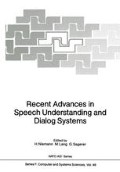Abstract
Parallel formant synthesis of speech is a well known technique used in building performant synthesis systems. The fact that the synthesizer parameters can be closely controlled permits to obtain very high quality synthetic speech. However, the extraction of the parameters is not an easy task, usually semi-automatic methods are used for this purpose.
Our aim is to extract these parameters as automatically as possible. Hence, we use suitable signal processing procedures, together with a-priori and context knowledge on speech in order to guide the analysis and correct eventual errors where the automatic procedures are unable to give the correct results. The fact that we already have a whole French diphone dictionary, analysed by an operator-controlled semiautomatic method will help us to gather the necessary a-priori knowledge of speech analysis. This analysis parameters are smoothed for all the diphones and then they are stored in a data-base form, we can then study the parameters’ behavior and integrate them in the analysis system, the long term object being synthesis by rule.
Access this chapter
Tax calculation will be finalised at checkout
Purchases are for personal use only
Preview
Unable to display preview. Download preview PDF.
Bibliography
Badin P. & Murillo G. 1983 An Analysis Method for High Quality Formant Synthesis. Proceedings of the 10 th Int. Cong, of Phon. Sc.
Bailly G. 1986 Détection du Fondamental par Prétraitement AMDF et Programmation Dynamique. 15 ème JEP Aix-en-Provence France.
Itahashi S. 1978 Description of Speech Data. Patterns by Several Functions. STL-QPSR 2–3 1978.
Markel J.D. & Gray A.H. 1976 Linear Prediction of Speech Springer-Verlag New York.
Kopec G.E. 1986 Formant Tracking using Hidden Markov Models and Vector Quantization. IEEE ASSP-34 N’ 4.
Newmann W. & Sproul R 1973. Principles of Computer Graphics. McGraw-Hill. New York.
Author information
Authors and Affiliations
Editor information
Editors and Affiliations
Rights and permissions
Copyright information
© 1988 Springer-Verlag Berlin Heidelberg
About this paper
Cite this paper
Al-Dakkak, O., Murillo, G., Bailly, G., Guérin, B. (1988). Using Contextual Information in View of Formant Speech Analysis Improvement. In: Niemann, H., Lang, M., Sagerer, G. (eds) Recent Advances in Speech Understanding and Dialog Systems. NATO ASI Series, vol 46. Springer, Berlin, Heidelberg. https://doi.org/10.1007/978-3-642-83476-9_8
Download citation
DOI: https://doi.org/10.1007/978-3-642-83476-9_8
Publisher Name: Springer, Berlin, Heidelberg
Print ISBN: 978-3-642-83478-3
Online ISBN: 978-3-642-83476-9
eBook Packages: Springer Book Archive

